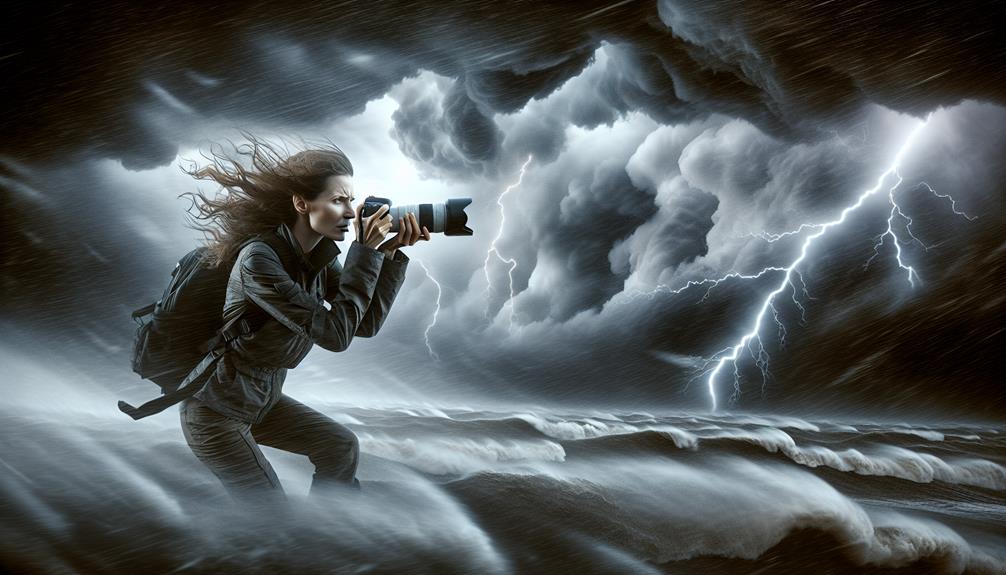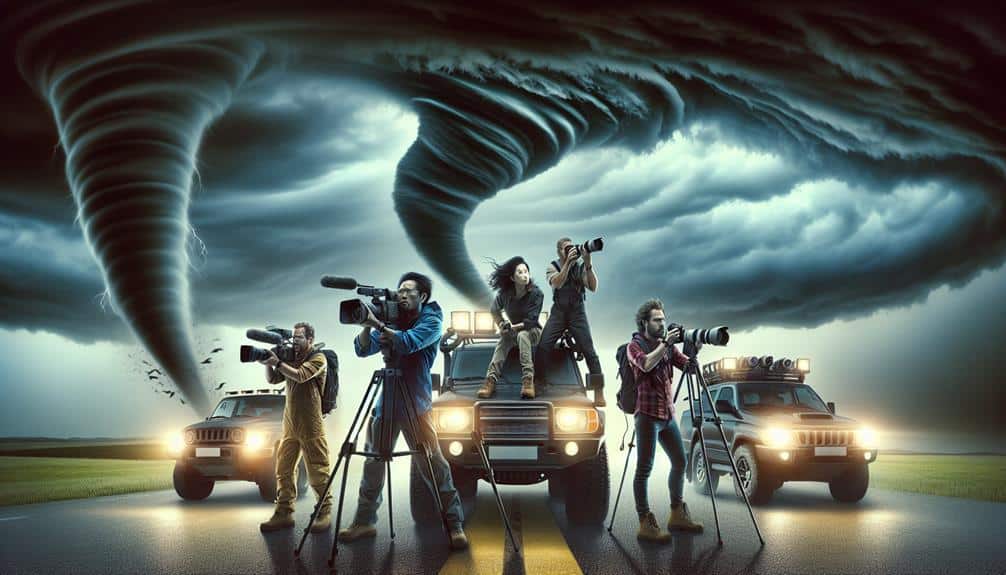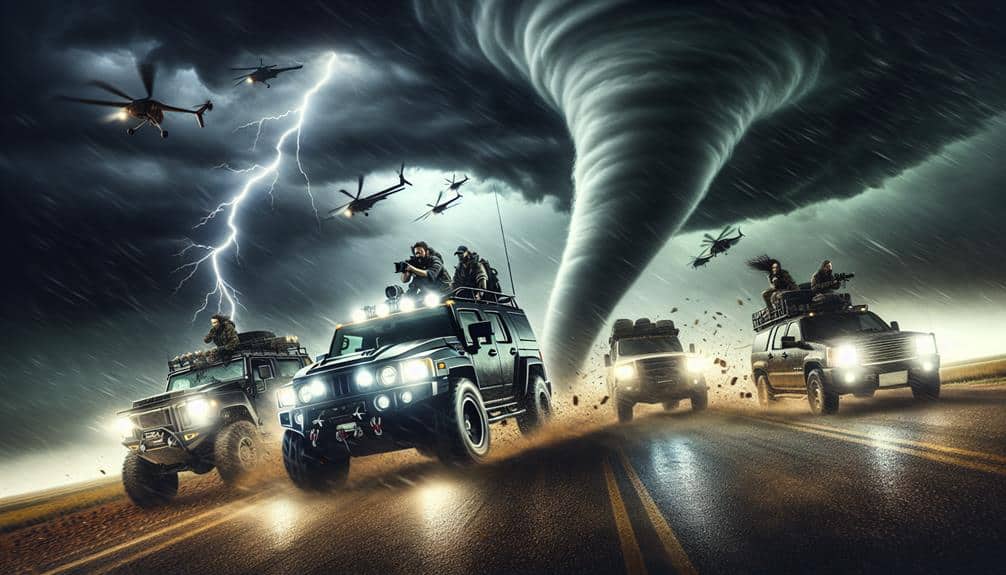We're driven by a complex mix of motives in storm chasing journalism. The adrenaline rush of tracking severe weather heightens our senses, while real-time data collection advances meteorological research. Our passion for storytelling and technology enhances public awareness, and our reports often guide emergency responses, improving community safety. Professional recognition brings career growth, and personal fulfillment comes from engaging in high-risk pursuits. These elements converge to fuel our relentless pursuit of nature's most dangerous phenomena. Discover the intricate balance of these motivations and how they shape our contributions to science and journalism.
Key Points
- Seeking thrill and excitement through tracking severe weather events.
- Contributing to meteorological research with real-time data collection.
- Passion for storytelling and informing the public about intense weather.
- Enhancing public safety by providing crucial real-time weather updates.
Thrill of the Chase
Many storm chaser journalists are motivated by an intrinsic need for excitement and the unmatched thrill that comes from tracking severe weather events. This rush of excitement isn't just a psychological desire; it's a complex interplay of physiological reactions that heightens our senses and sharpens our focus. When we're in the field, the stakes are high, and the margin for error is slim.
Our approach to storm chasing involves careful planning and accurate execution. We conduct thorough risk assessments before starting on any pursuit. This includes analyzing meteorological data, identifying potential dangers, and weighing the advantages against the inherent risks involved. Advanced tools like Doppler radar, satellite imagery, and predictive modeling play critical roles in our decision-making processes.
Furthermore, the dynamic nature of severe weather demands real-time adjustments. On-the-fly risk assessment is essential, as conditions can change rapidly. We constantly monitor updates and readjust our strategies to both safeguard and optimize in capturing compelling footage.
While the thrill fuels our passion, it's our analytical rigor and dedication to data-driven decision-making that allow us to pursue these hazardous yet exhilarating endeavors.
The freedom we experience in these high-stakes situations is unmatched, making every chase a proof of our dedication and precision.
Scientific Contribution
We actively contribute to advancing meteorological understanding through precise data collection during storms.
Our use of cutting-edge technology allows for real-time data acquisition, which supports predictive modeling and enhances safety protocols.
Advancing Meteorological Understanding
Storm chaser journalists greatly enhance meteorological research by providing real-time, on-the-ground data that improves predictive models and understanding of severe weather phenomena. Our involvement in the field has a substantial research impact, driving technological advancements and fostering academic collaborations.
By braving extreme conditions, we contribute invaluable insights that refine meteorological theories and enhance public safety measures.
Harnessing advanced equipment and methodologies, our fieldwork experiences yield critical data points that are often inaccessible through traditional means. Collaborative efforts with academic institutions and meteorological organizations amplify the scope and precision of our findings.
Key contributions include:
- Real-time data collection: Enables immediate analysis and model updates.
- Technological innovation: Drives the development of new tools and techniques.
- Enhanced predictive accuracy: Improves forecast reliability and timeliness.
- Risk assessment: Provides empirical data for better hazard evaluation.
Data Collection Techniques
To gather high-quality, actionable data, we employ a range of sophisticated techniques and instruments, ensuring our contributions to meteorological science are both precise and impactful. Our field observations leverage innovative technologies like mobile Doppler radar systems and deployable weather stations, which allow us to capture real-time data on storm dynamics. By using drone-based sensors, we can measure atmospheric variables such as temperature, humidity, and wind speed at different altitudes, providing a thorough view of storm behavior.
To guarantee our data collection is both effective and safe, we adhere to rigorous risk assessment and safety protocols. Before venturing into the field, we conduct detailed scenario analyses to predict potential hazards and determine the safest routes for data collection. Our vehicles are equipped with GPS systems, satellite communication, and real-time weather updates, enabling us to make informed decisions on the fly.
In addition, we utilize advanced software for data analysis and modeling, transforming raw data into meaningful insights. This analytical approach not only enhances our understanding of severe weather phenomena but also contributes to the broader meteorological community's knowledge base. By balancing innovative technologies with strict safety measures, we maximize both the accuracy and safety of our field observations.
Storytelling Passion

Driven by an insatiable curiosity and a desire to document the raw power of nature, storm chaser journalists often cite a profound passion for storytelling as a primary motivator. Our pursuit combines personal growth with creative expression, allowing us to capture and convey the extraordinary dynamics of severe weather events.
This storytelling passion isn't just about relaying facts; it's about crafting narratives that resonate deeply with our audience.
To understand why we chase storms for the sake of storytelling, consider the following factors:
- Personal Growth: Each chase challenges us, fostering resilience and adaptability.
- Creative Expression: Every storm provides a unique canvas for our photography and reporting skills.
- Engagement: Our stories captivate viewers, offering them a vicarious thrill and a deeper understanding of nature's ferocity.
- Educational Value: Through our work, people learn about meteorological phenomena and their impacts.
Our passion for storytelling drives us to push boundaries and seek out the most intense and awe-inspiring weather events. By doing so, we not only fulfill our creative and personal aspirations but also deliver powerful, data-driven stories that inform and engage the public.
Public Safety Mission
While our passion for storytelling is undeniable, our commitment to public safety stands as a cornerstone of our work as storm chaser journalists. We gather real-time data that directly influences emergency response strategies and disaster preparedness. By providing precise and timely information, we enable communities to make informed decisions, reducing the risks associated with severe weather events to a considerable extent.
Our efforts contribute to weather education by delivering accurate, contextualized information that demystifies meteorological phenomena. This educational component enhances public understanding and fosters a culture of preparedness. The data we collect is invaluable for meteorologists and emergency services, aiding in the development of robust community impact assessments and response plans.
We're not just capturing footage; we're actively participating in a larger mission of safeguarding lives. The immediacy of our reports can prompt quicker evacuations, more efficient resource allocation, and better overall emergency response. Each storm we chase adds to a growing repository of knowledge, ultimately improving the resilience of the communities we serve.
In essence, our role transcends journalism; it's a proactive engagement with public safety. By focusing on these critical aspects, we aim to empower individuals and communities, ensuring they're better equipped to face the unpredictable forces of nature.
Professional Recognition

When we consider professional recognition, we see that storm chaser journalists often pursue career advancement opportunities and aim for award-winning journalism.
Data indicates that industry awards and peer respect greatly enhance their professional credibility. This recognition not only boosts their individual profiles but also increases their influence within the journalism community.
Career Advancement Opportunities
Securing professional recognition in the storm chasing journalism industry is often a pivotal factor propelling professionals to pursue career advancement opportunities. By gaining acknowledgment for our work, we open various avenues that aid in our professional growth. The pursuit of such recognition isn't merely about accolades; it also ties directly to tangible benefits that impact our careers in significant ways.
- Salary potential: Recognition can lead to higher remuneration as it validates our expertise and dedication.
- Networking benefits: Being recognized opens doors to connect with industry leaders, enhancing our professional network.
- Job security: Acknowledged professionals often enjoy greater job stability due to their proven track record.
- Growth opportunities: Professional recognition can lead to promotions and new roles within the industry.
These factors collectively contribute to a more secure and prosperous career. In a field marked by inherent risks, the pursuit of professional recognition provides a pathway to not only secure our livelihood but also to achieve substantial career growth.
Award-Winning Journalism
Achieving award-winning journalism not only amplifies our professional recognition but also validates the rigorous standards and innovative approaches we bring to storm chasing reporting. By carefully adhering to investigative journalism principles, we make sure our media coverage remains both accurate and compelling. This commitment to high standards directly resonates with the public interest, making our work essential.
Our approach involves confronting ethical dilemmas head-on. For instance, capturing the raw power of tornadoes while safeguarding the safety and dignity of affected individuals requires a delicate balance. These ethical considerations drive us to adopt transparent methodologies and maintain the highest integrity in our reporting. Winning awards in journalism isn't just about accolades; it's about affirming that our investigative efforts meet and exceed industry benchmarks.
Data supports that award-winning stories often feature thorough analyses and real-time updates, which are vital in storm chasing scenarios. Our ability to deliver timely and reliable information has a tangible impact, informing communities and potentially saving lives. Essentially, the pursuit of professional recognition through award-winning journalism sharpens our focus, enhances our credibility, and ultimately serves the greater public interest.
Our dedication to these principles ensures that our work remains both impactful and respected.
Industry Peer Respect
Industry peer esteem in the storm chasing field is a critical metric of journalistic effectiveness and credibility. It is often quantified through peer-reviewed references and professional accolades. We rely on this respect to validate our work, knowing that our peers recognize the dedication and rigor we bring to our profession. This recognition isn't just a vanity metric but a confirmation of our adherence to stringent risk assessment and professional ethics.
Let's consider the following:
- Peer-Reviewed References: Our work gets referenced in academic journals, enhancing our credibility.
- Professional Awards: Winning industry-specific awards further solidifies our standing.
- Collaborative Projects: Engaging in joint ventures with reputable organizations increases our visibility.
- Conference Presentations: Sharing our findings at industry conferences allows us to showcase our expertise.
Personal Fulfillment
Pursuing storm chasing offers journalists a unique sense of personal fulfillment derived from the adrenaline rush and the opportunity to document nature's most extreme phenomena. This high-risk endeavor acts as a catalyst for self-discovery, pushing us to confront our limits and capabilities. It's not merely about capturing the perfect shot; it's about the journey and the personal growth we experience along the way.
From a data-driven perspective, studies show that individuals engaged in high-adrenaline activities report higher levels of life satisfaction and accomplishment. The act of storm chasing provides a tangible sense of achievement that many of us find deeply rewarding. We often analyze meteorological data, predict storm patterns, and make split-second decisions that test both our skills and resolve. Each successful chase reinforces our expertise and fuels our drive for future pursuits.
Furthermore, the documentation of these natural events serves a dual purpose: it fulfills our professional goals and satisfies our intrinsic desire for adventure. The sense of freedom we experience when facing untamed elements is unparalleled. By confronting nature's raw power, we uncover aspects of ourselves that remain dormant in more conventional settings. This pursuit of personal fulfillment keeps us returning to the storm's edge.
Frequently Asked Questions
How Do Storm Chasers Manage Their Mental Health During High-Stress Situations?
We employ self-care strategies and stress management techniques to handle high-stress situations. By maintaining mental health awareness and using effective coping mechanisms, we make sure we stay grounded and perform at our best, even under extreme conditions.
What Specialized Equipment Do Storm Chasers Use to Capture Footage?
Like modern-day Daedalus, we utilize drone technology and GoPro cameras to capture aerial views, while satellite imagery and GPS trackers guide our path. This specialized equipment guarantees precise, real-time data, empowering us to document nature's fury.
How Do Storm Chasers Financially Support Their Pursuits?
We rely on diverse funding sources, including sponsorships and crowdfunding, to financially support our storm chasing. Despite the financial risks, these methods provide the necessary resources, ensuring we can continue pursuing our passion for capturing extreme weather.
What Training or Qualifications Are Required to Become a Storm Chaser Journalist?
To become storm chaser journalists, we need Storm Chaser Certification, advanced weather knowledge, and extensive experience requirements. Safety training is essential for our protection. These qualifications guarantee we can safely and effectively report on severe weather events.
How Do Storm Chasers Coordinate With Local Authorities During Severe Weather Events?
We coordinate with local authorities by sharing real-time data and observations, enhancing emergency response efforts. Our collaboration guarantees public safety by providing critical information to decision-makers, helping communities prepare and respond effectively during severe weather events.


